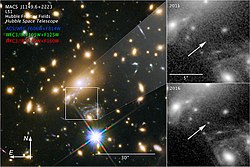 | |
| Discovery [2] | |
|---|---|
| Discovered by | Pan-STARRS 1 |
| Discovery site | Haleakala Obs. |
| Discovery date | 10 November 2017 (first observed only) |
| Designations | |
| 2017 VR12 | |
| NEO · PHA Apollo [3] · Amor [2] [a] | |
| Orbital characteristics [3] | |
| Epoch 23 March 2018 (JD 2458200.5) | |
| Uncertainty parameter 3 | |
| Observation arc | 118 days |
| Aphelion | 1.7389 AU |
| Perihelion | 1.0004 AU |
| 1.3697 AU | |
| Eccentricity | 0.2696 |
| 1.60 yr (585.50 d) | |
| 8.8927° | |
| 0° 36m 53.64s / day | |
| Inclination | 9.2247° |
| 347.32° | |
| 180.74° | |
| Earth MOID | 0.0077 AU (3.0 LD) |
| Physical characteristics | |
| Dimensions | 160 m × 100 m [4] |
| 160 m [1] | |
| 1.4 h [1] 1.5 h [5] | |
| V [1] | |
| 20.6 [3] | |
2017 VR12 is a sub-kilometer asteroid with a somewhat elongated and angular shape, approximately 160 meters (500 feet) in diameter. It is classified as near-Earth object and potentially hazardous asteroid of the Apollo or Amor group. [a] The V-type asteroid has a rotation period of approximately 1.5 hours. [5] It was first observed on 10 November 2017 by the 60-inch Pan-STARRS 1 telescope at Haleakala Observatory in Hawaii. [2] [3]








